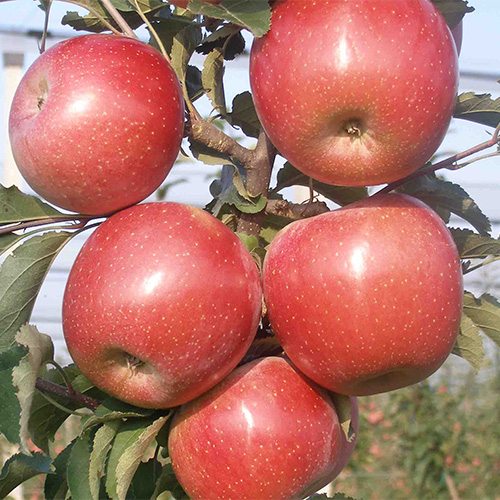
Fuji Zhen Aztec Apple Tree
Origin: Mexico
Description:The Fuji Zhen Aztec Apple Tree is a novel variety that combines the crisp texture of Fuji apples with the unique flavor profile of traditional Aztec varieties. It is known for its adaptability to various climates and soils, making it a versatile choice for growers. The tree exhibits a dense, compact growth, suitable for smaller spaces.
Fruit: The apples are medium to large with a smooth, shiny red skin interspersed with yellow undertones. The flesh is white, juicy, and sweet with a hint of spice, reflecting its Aztec heritage.
Harvest: The harvest season for Fuji Zhen Aztec apples starts in early October. The trees are prolific producers, often yielding a substantial crop.
Pollination: Beneficial to plant alongside other apple varieties such as Gala, McIntosh, or another Fuji variant to ensure effective pollination and improve fruit production.
Spacing: Optimal spacing is approximately 3 to 4 meters between trees, ideal for high-density orchards. Trees can grow to a medium height of about 3 to 4 meters.
Good to know: This variety boasts a longer shelf life and excellent resistance to both pests and diseases, reducing the need for chemical treatments. The fruits unique flavor and storability make it highly marketable.
ask prices
- We only sell bare root trees to countries in Europe. We can't export potted trees due to trade regulations.
- We can deliver the trees to all countries in Europe and some countries in Eurasia and Middle East. We can arrange a truck to deliver the trees to your country.
- We are a wholesale nursery. Our minimum order quantity is 3.000 trees. Please note that we don't take orders below this limit.
- Phytosanitary certificates are provided with all orders. These certificates prove the origin of the trees and certify that they are free of diseases.
MM 9 (Dwarf)
M 9 is a dwarf rootstock suitable for high-density planting. It is resistant to the crown rot disease and moderately sensitive to the fire blight and wooly aphid. It is resistant to the illness of the tree tree and mildly susceptible to the blight of flames and wooly aphid. Throughout cultivation, it requires support systems. It should not be grafted on spur-type varieties such as Scarlett Spur, Redchief and Starkspur Golden. For the field, it should be recommended without limiting watering. It is moderately resistant to calcareous and heavy-textured soils. High crop quality, early fruit bearing and elevated efficiency out of a unit region within a brief span of moment are the most advantageous features M 9 offers to the plants.
MM 106 (Middle size)
It is a semi-dwarf rootstock, resistant to wooly aphid and is highly sensitive to disease of crown rot. For heavy-textured and argillaceous soils, it should certainly not be suggested. It has a closer and heavier root structure than rootstocks M9 and M26. Although it is more resistant to the climate than rootstocks M9 and MM 26, it should be chosen for frequent watering plants.For the gardens where MM 106 is grown, support devices are not needed. Within three or four years after planting, it becomes commercially profitable.
MM 111 (Large)
It is a semi-dwarf rootstock bigger than M106 and smaller than standard seedling rootstock. It is resistant to the illness of crown rot, wooly aphid and heavy-textured, argillaceous, calcareous plants with a pH scale above 7. Depending on the circumstances of care, it becomes commercially profitable within four or five years. When early flowering is desired, M 9 may be recommended as the rootstock between the system in some cases. When grafted on spur form and low strength varieties, it provides stronger outcomes.






